Blog
Non-Diabetic Foot Ulcers
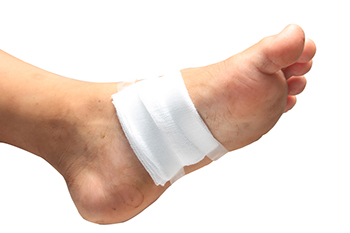
Non-diabetic foot ulcers are open sores or wounds that occur on the feet of individuals who do not have diabetes. While less common than diabetic foot ulcers, they still pose significant health risks. These ulcers can develop due to things like poor circulation, trauma, pressure, or infections. People at risk include those with peripheral artery disease, venous insufficiency, neuropathy, or autoimmune conditions. Additionally, lifestyle factors like smoking, obesity, and a sedentary lifestyle can increase the risk. Non-diabetic foot ulcers often manifest as painful lesions, typically on the bottom of the foot or toes. They require prompt medical attention to prevent complications such as infection or tissue damage. Treatment may involve wound care, infection management, pressure relief, and addressing underlying conditions contributing to ulcer formation. If you have sores on your feet that won't heal, it is strongly suggested that you schedule an appointment with a podiatrist as quickly as possible for a comprehensive treatment plan.
Wound care is an important part in dealing with diabetes. If you have diabetes and a foot wound or would like more information about wound care for diabetics, consult with one of our podiatrists from New York Foot and Ankle. Our doctors will assess your condition and provide you with quality foot and ankle treatment.
What Is Wound Care?
Wound care is the practice of taking proper care of a wound. This can range from the smallest to the largest of wounds. While everyone can benefit from proper wound care, it is much more important for diabetics. Diabetics often suffer from poor blood circulation which causes wounds to heal much slower than they would in a non-diabetic.
What Is the Importance of Wound Care?
While it may not seem apparent with small ulcers on the foot, for diabetics, any size ulcer can become infected. Diabetics often also suffer from neuropathy, or nerve loss. This means they might not even feel when they have an ulcer on their foot. If the wound becomes severely infected, amputation may be necessary. Therefore, it is of the upmost importance to properly care for any and all foot wounds.
How to Care for Wounds
The best way to care for foot wounds is to prevent them. For diabetics, this means daily inspections of the feet for any signs of abnormalities or ulcers. It is also recommended to see a podiatrist several times a year for a foot inspection. If you do have an ulcer, run the wound under water to clear dirt from the wound; then apply antibiotic ointment to the wound and cover with a bandage. Bandages should be changed daily and keeping pressure off the wound is smart. It is advised to see a podiatrist, who can keep an eye on it.
If you have any questions, please feel free to contact one of our offices located in Franklin Square, Bethpage, Brooklyn, and Massapequa, NY . We offer the newest diagnostic and treatment technologies for all your foot care needs.
Wounds That Don't Heal Need to Be Checked
Effective Foot Exercises for Ankle Arthritis
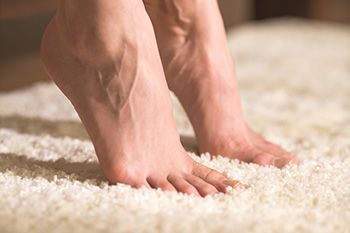
Ankle arthritis can be a debilitating condition, causing pain, stiffness, and reduced mobility. However, incorporating specific foot exercises into your daily routine can help alleviate symptoms and improve joint function. Toe curls are an excellent starting point, as they strengthen the muscles surrounding the ankle and increase flexibility. This is done by sitting with your feet flat on the floor and curling your toes towards the sole, holding for a few seconds before releasing. Another beneficial exercise is ankle circles, which involve gently rotating your ankle clockwise and counterclockwise to enhance range of motion and reduce stiffness. Calf raises can also be effective in strengthening the muscles supporting the ankle joint. Stand with your feet hip-width apart and slowly lift your heels off the ground, then lower them back down. Repeat this motion several times to build endurance and stability. If you have ankle arthritis, it is suggested that you seek the guidance of a podiatrist who can guide you toward additional exercises for relief.
Exercising your feet regularly with the proper foot wear is a great way to prevent injuries and build strength. If you have any concerns about your feet, contact one of our podiatrists from New York Foot and Ankle. Our doctors can provide the care you need to keep you pain-free and on your feet.
Exercise for Your Feet
Exercise for your feet can help you gain strength, mobility and flexibility in your feet. They say that strengthening your feet can be just as rewarding as strengthening another part of the body. Your feet are very important, and we often forget about them in our daily tasks. But it is because of our feet that are we able to get going and do what we need to. For those of us fortunate enough to not have any foot problems, it is an important gesture to take care of them to ensure good health in the long run.
Some foot health exercises can include ankle pumps, tip-toeing, toe rises, lifting off the floor doing reps and sets, and flexing the toes. It is best to speak with Our doctors to determine an appropriate regimen for your needs. Everyone’s needs and bodies are different, and the activities required to maintain strength in the feet vary from individual to individual.
Once you get into a routine of doing regular exercise, you may notice a difference in your feet and how strong they may become.
If you have any questions please feel free to contact one of our offices located in Franklin Square, Bethpage, Brooklyn, and Massapequa, NY . We offer the newest diagnostic and treatment technologies for all your foot and ankle needs.
How Peripheral Artery Disease Impacts the Feet
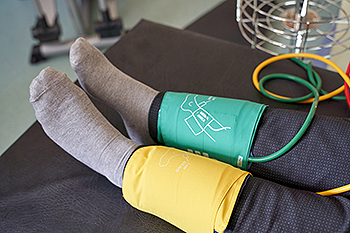 Peripheral artery disease, PAD, is a circulatory condition that significantly impairs the flow of blood to the extremities, particularly the feet. PAD can pose serious health risks and include symptoms that can drastically affect daily living. This condition results from the accumulation of fatty deposits in the arteries, causing them to narrow. This also causes a reduction in blood supply. People with PAD may experience various symptoms in their feet, including a notable decrease in temperature compared to the rest of the body, a change in skin color to a pale or bluish hue, diminished hair growth, delayed wound healing, and sores. Furthermore, PAD can lead to pain or cramping in the lower limbs during physical activities. This typically subsides with rest. The risks of PAD go beyond discomfort because the decreased blood flow heightens the risk of infection. Severe cases can lead to gangrene and the possibility of amputation. If you are suffering from PAD, it is suggested you seek the help of a podiatrist, or foot doctor, who can provide a personalized treatment plan and address any foot-related concerns.
Peripheral artery disease, PAD, is a circulatory condition that significantly impairs the flow of blood to the extremities, particularly the feet. PAD can pose serious health risks and include symptoms that can drastically affect daily living. This condition results from the accumulation of fatty deposits in the arteries, causing them to narrow. This also causes a reduction in blood supply. People with PAD may experience various symptoms in their feet, including a notable decrease in temperature compared to the rest of the body, a change in skin color to a pale or bluish hue, diminished hair growth, delayed wound healing, and sores. Furthermore, PAD can lead to pain or cramping in the lower limbs during physical activities. This typically subsides with rest. The risks of PAD go beyond discomfort because the decreased blood flow heightens the risk of infection. Severe cases can lead to gangrene and the possibility of amputation. If you are suffering from PAD, it is suggested you seek the help of a podiatrist, or foot doctor, who can provide a personalized treatment plan and address any foot-related concerns.
Peripheral artery disease can pose a serious risk to your health. It can increase the risk of stroke and heart attack. If you have symptoms of peripheral artery disease, consult with one of our podiatrists from New York Foot and Ankle. Our doctors will assess your condition and provide you with quality foot and ankle treatment.
Peripheral artery disease (PAD) is when arteries are constricted due to plaque (fatty deposits) build-up. This results in less blood flow to the legs and other extremities. The main cause of PAD is atherosclerosis, in which plaque builds up in the arteries.
Symptoms
Symptoms of PAD include:
- Claudication (leg pain from walking)
- Numbness in legs
- Decrease in growth of leg hair and toenails
- Paleness of the skin
- Erectile dysfunction
- Sores and wounds on legs and feet that won’t heal
- Coldness in one leg
It is important to note that a majority of individuals never show any symptoms of PAD.
Diagnosis
While PAD occurs in the legs and arteries, Podiatrists can diagnose PAD. Podiatrists utilize a test called an ankle-brachial index (ABI). An ABI test compares blood pressure in your arm to you ankle to see if any abnormality occurs. Ultrasound and imaging devices may also be used.
Treatment
Fortunately, lifestyle changes such as maintaining a healthy diet, exercising, managing cholesterol and blood sugar levels, and quitting smoking, can all treat PAD. Medications that prevent clots from occurring can be prescribed. Finally, in some cases, surgery may be recommended.
If you have any questions, please feel free to contact one of our offices located in Franklin Square, Bethpage, Brooklyn, and Massapequa, NY . We offer the newest diagnostic and treatment technologies for all your foot care needs.
Avoiding Blisters While Breaking in New Shoes
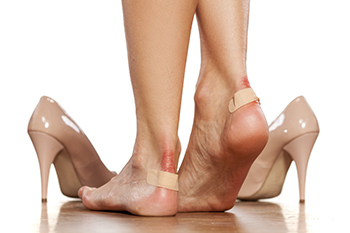
When it comes to new shoes, avoiding foot blisters is essential for comfort and enjoyment. Start by selecting shoes made of breathable materials that conform to the shape of your foot. Before wearing them for extended periods, gradually break in your shoes by wearing them for short intervals around the house. Consider using protective products like blister patches on areas prone to rubbing, such as the heels or toes. Ensure a proper fit by leaving enough space for your toes to wiggle and avoiding shoes that are too tight or too loose. Opt for socks made of moisture-wicking materials to keep your feet dry and reduce friction. Additionally, consider applying a thin layer of petroleum jelly to areas prone to blistering before putting on your shoes. By following these tips and being mindful of potential hot spots, you can prevent foot blisters and enjoy your new shoes comfortably from the start. If you have developed problematic blisters from wearing new shoes, it is suggested that you confer with a podiatrist for treatment.
Blisters may appear as a single bubble or in a cluster. They can cause a lot of pain and may be filled with pus, blood, or watery serum. If your feet are hurting, contact one of our podiatrists of New York Foot and Ankle. Our doctors can provide the care you need to keep you pain-free and on your feet.
Foot Blisters
Foot blisters are often the result of friction. This happens due to the constant rubbing from shoes, which can lead to pain.
What Are Foot Blisters?
A foot blister is a small fluid-filled pocket that forms on the upper-most layer of the skin. Blisters are filled with clear fluid and can lead to blood drainage or pus if the area becomes infected.
Symptoms
(Blister symptoms may vary depending on what is causing them)
- Bubble of skin filled with fluid
- Redness
- Moderate to severe pain
- Itching
Prevention & Treatment
In order to prevent blisters, you should be sure to wear comfortable shoes with socks that cushion your feet and absorb sweat. Breaking a blister open may increase your chances of developing an infection. However, if your blister breaks, you should wash the area with soap and water immediately and then apply a bandage to the affected area. If your blisters cause severe pain it is important that you call your podiatrist right away.
If you have any questions, please feel free to contact one of our offices located in Franklin Square, Bethpage, Brooklyn, and Massapequa, NY . We offer the newest diagnostic and treatment technologies for all your foot care needs.
Addressing Challenges in Foot Care Among Older Adults
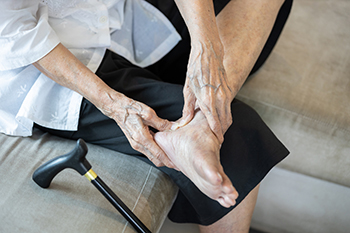
As individuals age, the importance of proper foot care becomes increasingly evident. However, older people often face unique challenges in maintaining good foot health. Reduced mobility and flexibility can make it difficult for seniors to attend to their feet regularly. Conditions such as arthritis can further impede their ability to perform basic foot care tasks like trimming nails or inspecting for cuts and sores. Additionally, age-related changes in skin and circulation increase the risk of developing foot problems such as corns, calluses, and infections. Furthermore, chronic health conditions like diabetes can exacerbate these issues, as diabetic neuropathy may diminish sensation in the feet, making it harder to feel injuries or wounds. Lack of awareness about the importance of foot care and its relationship to overall health also contributes to neglect in this area. If you or a loved one is elderly, it is suggested that an appointment with a podiatrist is scheduled who can provide you with effective foot care tips and treatment.
If you need your feet checked, contact one of our podiatrists of New York Foot and Ankle. Our doctors will attend to all of your foot and ankle needs and provide you with quality treatment.
Geriatrics and Podiatry
When people age, some common issues that may occur are bone density loss, dry skin, poor circulation, and rough brittle nails. These issues may also affect your foot health if the necessary steps are not taken to alleviate the problems.
It is important to take care of your feet because feet that are injured or diseased can affect your overall health. Having painful feet hinders your ability to do daily activities or may decrease your willingness to do the things that you need to do.
Visiting Your Geriatrician
As we age, health problems become more likely, so it is essential to visit your doctor for check-ups to ensure that you are doing the best you can to take care of your health. It is recommended to check your feet frequently for any possible cuts, bruises, swelling, corns or any other irregularities.
Taking Care of Elderly Feet
Cracked or dry feet can be treated by applying moisturizer often. It is also important not to wear old socks because the older the sock is, the higher the possibility there will be that there is bacteria there. Wear fresh socks and make sure they fit properly.
Proper foot health means that you can have a more active lifestyle and you will not be bogged down by pain. Foot health also leads to good circulation, which is paramount for overall health.
If you have any questions, please feel free to contact one of our offices located in Franklin Square, Bethpage, Brooklyn, and Massapequa, NY . We offer the newest diagnostic tools and technology to treat your foot and ankle needs.
It's Time for Beautiful Feet
Foot Health and General Wellness
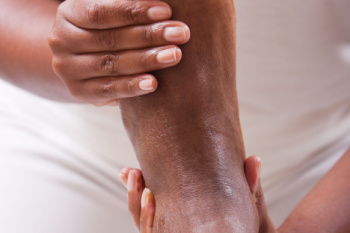
Good foot health is integral to overall well-being. Podiatrists play a vital role in maintaining both foot and general health. These doctors diagnose and treat various foot conditions, such as bunions, plantar fasciitis, and ingrown toenails, preventing further complications. Podiatrists also address systemic issues like diabetes and arthritis, which often manifest in the feet. By providing custom orthotics, they improve biomechanical alignment, reducing pain and enhancing mobility. Regular foot examinations by a podiatrist can detect early signs of systemic diseases, facilitating timely intervention. Additionally, podiatrists offer education on foot care practices and footwear selection, promoting preventive measures for optimal foot health. If you have problems or concerns about your foot health, it is suggested that you schedule an appointment with a podiatrist for a consultation and any treatment that is deemed necessary.
Everyday foot care is very important to prevent infection and other foot ailments. If you need your feet checked, contact one of our podiatrists from New York Foot and Ankle. Our doctors can provide the care you need to keep you pain-free and on your feet.
Everyday Foot Care
Often, people take care of their bodies, face and hair more so than they do for their feet. But the feet are a very important aspect of our bodies, and one that we should pay more attention to. Without our feet, we would not be able to perform most daily tasks.
It is best to check your feet regularly to make sure there are no new bruises or cuts that you may not have noticed before. For dry feet, moisturizer can easily be a remedy and can be applied as often as necessary to the affected areas. Wearing shoes that fit well can also help you maintain good foot health, as well as making it easier to walk and do daily activities without the stress or pain of ill-fitting shoes, high heels, or even flip flops. Wearing clean socks with closed shoes is important to ensure that sweat and bacteria do not accumulate within the shoe. Clean socks help to prevent Athlete’s foot, fungi problems, bad odors, and can absorb sweat.
If you have any questions please feel free to contact one of our offices located in Franklin Square, Bethpage, Brooklyn, and Massapequa, NY . We offer the newest diagnostic and treatment technologies for all your foot and ankle needs.
Causes of Pinky Toe Pain
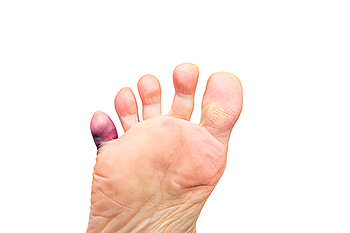
Experiencing pain in the pinky toe can be discomforting, yet understanding the causes behind it can offer clarity and relief. One common culprit is wearing ill-fitting footwear, particularly shoes that are too narrow or have inadequate toe space, which can compress the pinky toe and lead to friction and discomfort. Additionally, repetitive activities such as running or walking long distances can strain the muscles and joints in the pinky toe, resulting in pain and inflammation. Injuries such as stubbing the toe or dropping a heavy object on it can also cause acute pain and swelling. Moreover, conditions like bunions or hammertoes can affect the alignment of the toes, putting extra pressure on the pinky toe and causing pain over time. Understanding the diverse causes of pinky toe pain empowers individuals to take proactive measures, such as wearing properly fitting shoes, and practicing good foot hygiene. If your pinky toe hurts, it is suggested that you contact a podiatrist who can determine what the cause is, and offer appropriate treatment options.
Toe pain can disrupt your daily activities. If you have any concerns, contact one of our podiatrists of New York Foot and Ankle. Our doctors can provide the care you need to keep you pain-free and on your feet.
What Causes Toe Pain?
Most severe toe pain is caused due to a sports injury, trauma from dropping something heavy on the toe, or bumping into something rigid. Other problems can develop over time for various reasons.
Toe pain can be caused by one or more ailments. The most common include:
- Trauma
- Sports injury
- Wearing shoes that are too tight
- Arthritis
- Gout
- Corns and calluses
- Hammertoe
- Bunions
- Blisters
- Ingrown toenails
- Sprains
- Fractures (broken bones)
- Dislocations
When to See a Podiatrist
- Severe pain
- Persistent pain that lasts more than a week
- Signs of infection
- Continued swelling
- Pain that prevents walking
Diagnosis
In many cases the cause of toe pain is obvious, but in others, a podiatrist may want to use more advanced methods to determine the problem. These can range from simple visual inspections and sensation tests to X-rays and MRI scans. Prior medical history, family medical history, and any recent physical traumatic events will all be taken into consideration for a proper diagnosis.
Treatment
Treatments for toe pain and injuries vary and may include shoe inserts, padding, taping, medicines, injections, and in some cases, surgery. If you believe that you have broken a toe, please see a podiatrist as soon as possible.
If you have any questions please feel free to contact one of our offices located in Franklin Square, Bethpage, Brooklyn, and Massapequa, NY . We offer the newest diagnostic tools and technology to treat your foot and ankle needs.
Stiff Big Toe and Orthotics
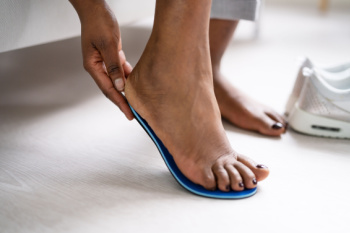
Hallux limitus is a condition where the big toe joint gets sore, stiff, and inflamed. If not treated, it can turn into hallux rigidus, where the joint cannot move, causing a lot of pain and difficulty walking. To help with these issues, foot doctors focus on making the joint move better to reduce pain and improve how it works. They often use special shoe inserts with a deeper heel and a part that supports the inside of the foot. The doctors also look at whether the problem is because the joint does not work well or if it is because of the shape of the foot. Depending on the issue, they may use different kinds of inserts. They usually avoid certain materials and features that can make things worse. When making these inserts for everyday shoes, podiatrists think about things like foot strength and how the foot lines up. They may suggest exercises, massage, and good shoes. If you have a stiff and painful big toe, it is suggested that you schedule an appointment with a podiatrist for treatment, which may include orthotics.
If you are having discomfort in your feet and would like to try orthotics, contact one of our podiatrists from New York Foot and Ankle. Our doctors can provide the care you need to keep you pain-free and on your feet.
What Are Orthotics?
Orthotics are inserts you can place into your shoes to help with a variety of foot problems such as flat feet or foot pain. Orthotics provide relief and comfort for minor foot and heel pain but can’t correct serious biomechanical problems in your feet.
Over-the-Counter Inserts
Orthotics come in a wide variety of over-the-counter inserts that are used to treat foot pain, heel pain, and minor problems. For example, arch supports can be inserted into your shoes to help correct overarched or flat feet, while gel insoles are often used because they provide comfort and relief from foot and heel pain by alleviating pressure.
Prescription Orthotics
If over-the-counter inserts don’t work for you or if you have a more severe foot concern, it is possible to have your podiatrist prescribe custom orthotics. These high-quality inserts are designed to treat problems such as abnormal motion, plantar fasciitis, and severe forms of heel pain. They can even be used to help patients suffering from diabetes by treating foot ulcers and painful calluses and are usually molded to your feet individually, which allows them to provide full support and comfort.
If you are experiencing minor to severe foot or heel pain, it’s recommended to speak with your podiatrist about the possibilities of using orthotics. A podiatrist can determine which type of orthotic is right for you and allow you to take the first steps towards being pain-free.
If you have any questions please contact one of our offices located in Franklin Square, Bethpage, Brooklyn, and Massapequa, NY . We offer the newest diagnostic and treatment technologies for all your foot and ankle needs.
More...
Wound Debridement
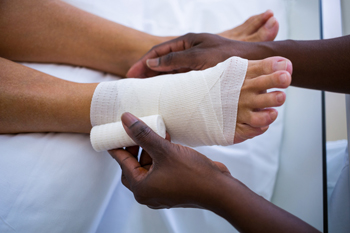
Debridement wound care is often necessary for the proper healing and prevention of complications in foot wounds. Debridement, whether with special dressings, maggots, or mechanical methods, aids in removing dead or infected tissue and facilitates healing. After this procedure, it is important to regularly change the dressing, as per your podiatrist’s instructions. Keeping the dressing dry by avoiding activities like swimming or hot tubs is vital. Always maintain cleanliness by washing your hands before and after touching the wound. Avoid applying pressure and use cushions or crutches, if necessary. While debridement carries potential risks like irritation, bleeding, or infection, its benefits often outweigh these. Pay attention to signs of infection, such as increasing pain, redness, swelling, or fever. If you have foot wounds or have had a debridement procedure and healing is slower than expected or shows signs of infection, it is strongly suggested that you schedule an appointment with a podiatrist for care.
Wound care is an important part in dealing with diabetes. If you have diabetes and a foot wound or would like more information about wound care for diabetics, consult with one of our podiatrists from New York Foot and Ankle. Our doctors will assess your condition and provide you with quality foot and ankle treatment.
What Is Wound Care?
Wound care is the practice of taking proper care of a wound. This can range from the smallest to the largest of wounds. While everyone can benefit from proper wound care, it is much more important for diabetics. Diabetics often suffer from poor blood circulation which causes wounds to heal much slower than they would in a non-diabetic.
What Is the Importance of Wound Care?
While it may not seem apparent with small ulcers on the foot, for diabetics, any size ulcer can become infected. Diabetics often also suffer from neuropathy, or nerve loss. This means they might not even feel when they have an ulcer on their foot. If the wound becomes severely infected, amputation may be necessary. Therefore, it is of the upmost importance to properly care for any and all foot wounds.
How to Care for Wounds
The best way to care for foot wounds is to prevent them. For diabetics, this means daily inspections of the feet for any signs of abnormalities or ulcers. It is also recommended to see a podiatrist several times a year for a foot inspection. If you do have an ulcer, run the wound under water to clear dirt from the wound; then apply antibiotic ointment to the wound and cover with a bandage. Bandages should be changed daily and keeping pressure off the wound is smart. It is advised to see a podiatrist, who can keep an eye on it.
If you have any questions, please feel free to contact one of our offices located in Franklin Square, Bethpage, Brooklyn, and Massapequa, NY . We offer the newest diagnostic and treatment technologies for all your foot care needs.
Symptoms and Long-Term Implications of a Broken Toe
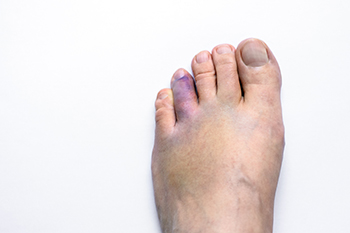
A broken toe, though seemingly minor, can yield noticeable symptoms and potential long-term complications. Immediate signs include pain, swelling, and bruising around the affected toe. Limited mobility and difficulty bearing weight are common, making daily activities challenging. If left untreated, a broken toe may lead to complications, such as deformities where the toe heals in a misaligned position. Chronic pain can persist, hindering mobility. In some cases, arthritis may develop, accelerating joint degeneration over time. Nerve damage is another potential consequence, causing tingling or numbness. Seeking prompt medical attention, including having X-rays taken for an accurate diagnosis, is vital to ensure proper realignment and minimize the risk of enduring complications. If you have endured a broken toe, it is suggested that you visit a podiatrist who can effectively treat this condition and guide you toward avoiding long-term complications.
A broken toe can be very painful and lead to complications if not properly fixed. If you have any concerns about your feet, contact one of our podiatrists from New York Foot and Ankle. Our doctors will treat your foot and ankle needs.
What to Know About a Broken Toe
Although most people try to avoid foot trauma such as banging, stubbing, or dropping heavy objects on their feet, the unfortunate fact is that it is a common occurrence. Given the fact that toes are positioned in front of the feet, they typically sustain the brunt of such trauma. When trauma occurs to a toe, the result can be a painful break (fracture).
Symptoms of a Broken Toe
- Throbbing pain
- Swelling
- Bruising on the skin and toenail
- The inability to move the toe
- Toe appears crooked or disfigured
- Tingling or numbness in the toe
Generally, it is best to stay off of the injured toe with the affected foot elevated.
Severe toe fractures may be treated with a splint, cast, and in some cases, minor surgery. Due to its position and the pressure it endures with daily activity, future complications can occur if the big toe is not properly treated.
If you have any questions please feel free to contact one of our offices located in Franklin Square, Bethpage, Brooklyn, and Massapequa, NY . We offer the newest diagnostic and treatment technologies for all your foot and ankle needs.
Heel Pain Can Be Treated!
Safe Foods to Consume With Gout
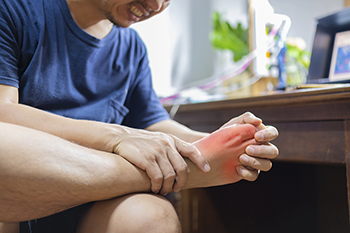
Gout, a form of arthritis caused by excess uric acid in the bloodstream and often causing pain in the big toe joint, necessitates a dietary approach that carefully selects foods to manage symptoms. Opting for low-purine choices is key, as purines metabolize into uric acid. Fruits such as cherries, berries, and citrus fruits boast anti-inflammatory properties, aiding in gout management. Vegetables like kale, cabbage, and bell peppers are low in purines and rich in vitamins. Whole grains, including brown rice and quinoa, serve as nutritious alternatives to refined grains. Proteins from low-purine sources, such as tofu, legumes, and low-fat dairy, offer essential nutrients without exacerbating uric acid levels. Hydration is vital, and ample water intake helps to flush out excess uric acid. Limiting alcohol consumption, particularly beer and spirits is advisable. If you have been afflicted with gout, it is strongly suggested that you are under the care of a podiatrist who can help you to manage this painful condition.
Gout is a painful condition that can be treated. If you are seeking treatment, contact one of our podiatrists from New York Foot and Ankle. Our doctors will treat your foot and ankle needs.
What Is Gout?
Gout is a form of arthritis that is characterized by sudden, severe attacks of pain, redness, and tenderness in the joints. The condition usually affects the joint at the base of the big toe. A gout attack can occur at any random time, such as the middle of the night while you are asleep.
Symptoms
- Intense Joint Pain - Usually around the large joint of your big toe, and it most severe within the first four to twelve hours
- Lingering Discomfort - Joint discomfort may last from a few days to a few weeks
- Inflammation and Redness -Affected joints may become swollen, tender, warm and red
- Limited Range of Motion - May experience a decrease in joint mobility
Risk Factors
- Genetics - If family members have gout, you’re more likely to have it
- Medications - Diuretic medications can raise uric acid levels
- Gender/Age - Gout is more common in men until the age of 60. It is believed that estrogen protects women until that point
- Diet - Eating red meat and shellfish increases your risk
- Alcohol - Having more than two alcoholic drinks per day increases your risk
- Obesity - Obese people are at a higher risk for gout
Prior to visiting your podiatrist to receive treatment for gout, there are a few things you should do beforehand. If you have gout you should write down your symptoms--including when they started and how often you experience them, important medical information you may have, and any questions you may have. Writing down these three things will help your podiatrist in assessing your specific situation so that he or she may provide the best route of treatment for you.
If you have any questions, please feel free to contact one of our offices located in Franklin Square, Bethpage, Brooklyn, and Massapequa, NY . We offer the newest diagnostic and treatment technologies for all your foot care needs.



